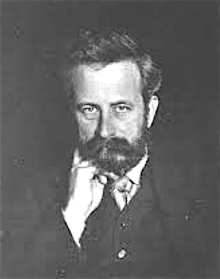
Alfred Hoare Powell [commonly known as Alfred Powell; and as Alfred H. Powell] was born Bisham, Berkshire, England on 14 April 1865 and was articled to William Oswald Milne (1847-1927) in London for three years, during which time he attended the Slade School of Fine Art, University College, London. From 1887 to 1892 he worked in the office of John Dando Sedding (1838-1891) in London. In 1893 he was awarded the RIBA Owen Jones Travelling Scholarship and spent three months in Italy with his friend the designer John Paul Cooper (1869-1933).
Following his return to England, he trained in the craft of carpentry in Abinger, near Dorking, Surrey in 1894. He also joined the Society for the Protection of Ancient Buildings (SPAD) and undertook repair and restoration work on behalf of the Society, including at the Clergy House in Alfriston, Sussex, the first house owned by the National Trust.
In 1897 Powell shared an office in London with the architect Detmar Blow (1867-1939) and the following year he and Blow worked together on the restoration of Joiners Hall in Salisbury.
In 1898 Powell relocated his office to Guildford in Surrey. In the early 1900s he moved to the Cotswolds where he began an association with Ernest Gimson (1864-1919) and Sidney Barnsley (1865-1926) and Ernest Barnsley (1863-1926) who had established a craft workshop in Sapperton in Gloucestershire. He settled nearby at Gurners Farm in Oakridge Lynch in 1902. Powell then embarked on various architectural projects in the Cotswold area. He also set up his own craft workshop making traditional ladder-back chairs.
In 1904 Powell's career took a new direction. He started hand-painting ceramics for Josiah Wedgwood & Sons. About this time he met and in 1906. married Ada Louise Lessore (1865-1956), subsequently known as Louise Powell. She had studied painting at the Slade School of Fine Art and calligraphy and illuminating at the LCC Central School of Arts and Crafts, in London and subsequently collaborated with her husband in designing and painting ceramics for Wedgwood. In 1907 the firm set up a studio expressly for them in Red Lion Square in London. Thus began an association between the Powells and Wedgwood that was to continue for the next four decades.
The Powells lived in London but maintained a studio in the Cotswolds. Alfred Powell taught pottery painting at Central School of Arts and Crafts and continued his connection with Gimson for whom he occasionally produced decorative woodwork. Powell was one of the team of craftsmen engaged in the twenty-year project to build and decorate Rodmarton Manor in Cirencester, completed in the late 1920s.
He was a member of the Arts & Crafts Exhibition Society and participated in their 7th (1903), 8th (1906), 9th (1910), 10th (1912), and 11th (1916) exhibitions in London. He also exhibited at the Royal Academy in London in 1890 and 1891, and at at Baillie Gallery in London in 1925. In 1925 and 1926 he exhibited jointly with Louise at the Walker Art Gallery in Liverpool.
The Powells' address was given as a 29B Lincoln's Inn Fields, London in 1906; 23 Westbourne Square, London in 1906 and 1910; Gunners Farm, Oakridge Lynch, Stroud, Gloucestershire in 1911 and 1912; Volta House, Windmill Hill, Hampstead, London in 1915 and 1919; 40 Mecklenburgh Square, St Pancras, London in 1920; 9 Bayley Street, Holborn, London in 1926 and 1936; and 86g Holland Park, Kensington, London in 1947 and 1948. Louise died in London on 30 September 1956. Alfred Powell died in Ealing, London on 29 May 1960. His address at the time of his death was 53 Addison Avenue, London.
Armstrong, Barrie and Armstrong, Wendy. The Arts and Crafts movement in Yorkshire: a handbook. etherby, England: Oblong Creative Ltd., 2013
Drury, Michael. Wandering Architects. In Pursuit of an Arts and Crafts Ideal. Donington: Shaun Tyas, revised edition, 2016 [Chapter 3. A hard road. Alfred Powell's career before 1900. pp. 44-61]
Good workmanship with happy thought: the work of Alfred and Louise Powell. Cheltenham, Gloucestershire: Cheltenham Art Gallery and Museums, 1992
Simpicity or Splendour. Arts and Crafts Living. Objects from the Cheltenham Collection. Edited by Annette Carruthers and Mary Greensted. London: Cheltenham Art Gallery and Museums in Association with Lund Humphries Publishers, 1999
Sarsby, Jacqueline. ‘Alfred Powell: Idealism and Realism in the Cotswolds’. Journal of Design History Vol. 10, No. 4, 1997 pp. 375-397